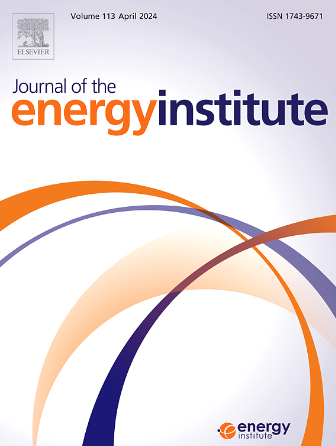Experimental study on co-gasification of cellulose and high-density polyethylene with CO2
IF 5.6
2区 工程技术
Q2 ENERGY & FUELS
引用次数: 0
Abstract
Co-gasification of biomass and waste plastic with CO2 presents an effective strategy for integrating biomass conversion, waste utilization and carbon recycling. In this study, the co-gasification of cellulose and high-density polyethylene with CO2 was investigated experimentally. The effects of mixing ratio and temperature on co-gasification characteristics, including gas yield, product gas composition, lower heating value of syngas and gasification efficiency, were comprehensively evaluated. Additionally, the interaction between cellulose and high-density polyethylene was analyzed. The results suggested that increasing the polyethylene content in feedstock resulted in decreased yields of H2 and CO, increased CH4 yield, increased lower heating value of syngas and reduced gasification efficiency. The interaction between cellulose and high-density polyethylene enhanced the gas yield, with the most significant effect at 40 % polyethylene content. In the range of 900 °C–1000 °C, increasing the temperature resulted in increased gas yield, reduced lower heating value of syngas and increased gasification efficiency. The positive interaction between cellulose and high-density polyethylene on gas yield was more significant at higher temperatures. This work shed light on reaction characteristics for co-gasification of biomass and high-density polyethylene with CO2, laying the foundation for the design and application of this technology.
纤维素和高密度聚乙烯与二氧化碳共气化实验研究
生物质和废塑料与二氧化碳共气化是一种集生物质转化、废物利用和碳回收于一体的有效策略。本研究对纤维素和高密度聚乙烯与二氧化碳的共气化进行了实验研究。全面评估了混合比和温度对共气化特性的影响,包括产气量、产品气体成分、合成气的较低热值和气化效率。此外,还分析了纤维素与高密度聚乙烯之间的相互作用。结果表明,增加原料中的聚乙烯含量会导致 H2 和 CO 产率降低、CH4 产率增加、合成气热值降低和气化效率降低。纤维素和高密度聚乙烯之间的相互作用提高了气体产率,聚乙烯含量为 40% 时效果最显著。在 900 ℃-1000 ℃ 范围内,提高温度可增加产气量,降低合成气的较低热值,提高气化效率。在较高温度下,纤维素和高密度聚乙烯对产气量的正向作用更为显著。这项工作阐明了生物质和高密度聚乙烯与二氧化碳共气化的反应特性,为该技术的设计和应用奠定了基础。
本文章由计算机程序翻译,如有差异,请以英文原文为准。
求助全文
约1分钟内获得全文
求助全文
来源期刊

Journal of The Energy Institute
工程技术-能源与燃料
CiteScore
10.60
自引率
5.30%
发文量
166
审稿时长
16 days
期刊介绍:
The Journal of the Energy Institute provides peer reviewed coverage of original high quality research on energy, engineering and technology.The coverage is broad and the main areas of interest include:
Combustion engineering and associated technologies; process heating; power generation; engines and propulsion; emissions and environmental pollution control; clean coal technologies; carbon abatement technologies
Emissions and environmental pollution control; safety and hazards;
Clean coal technologies; carbon abatement technologies, including carbon capture and storage, CCS;
Petroleum engineering and fuel quality, including storage and transport
Alternative energy sources; biomass utilisation and biomass conversion technologies; energy from waste, incineration and recycling
Energy conversion, energy recovery and energy efficiency; space heating, fuel cells, heat pumps and cooling systems
Energy storage
The journal''s coverage reflects changes in energy technology that result from the transition to more efficient energy production and end use together with reduced carbon emission.
 求助内容:
求助内容: 应助结果提醒方式:
应助结果提醒方式:


